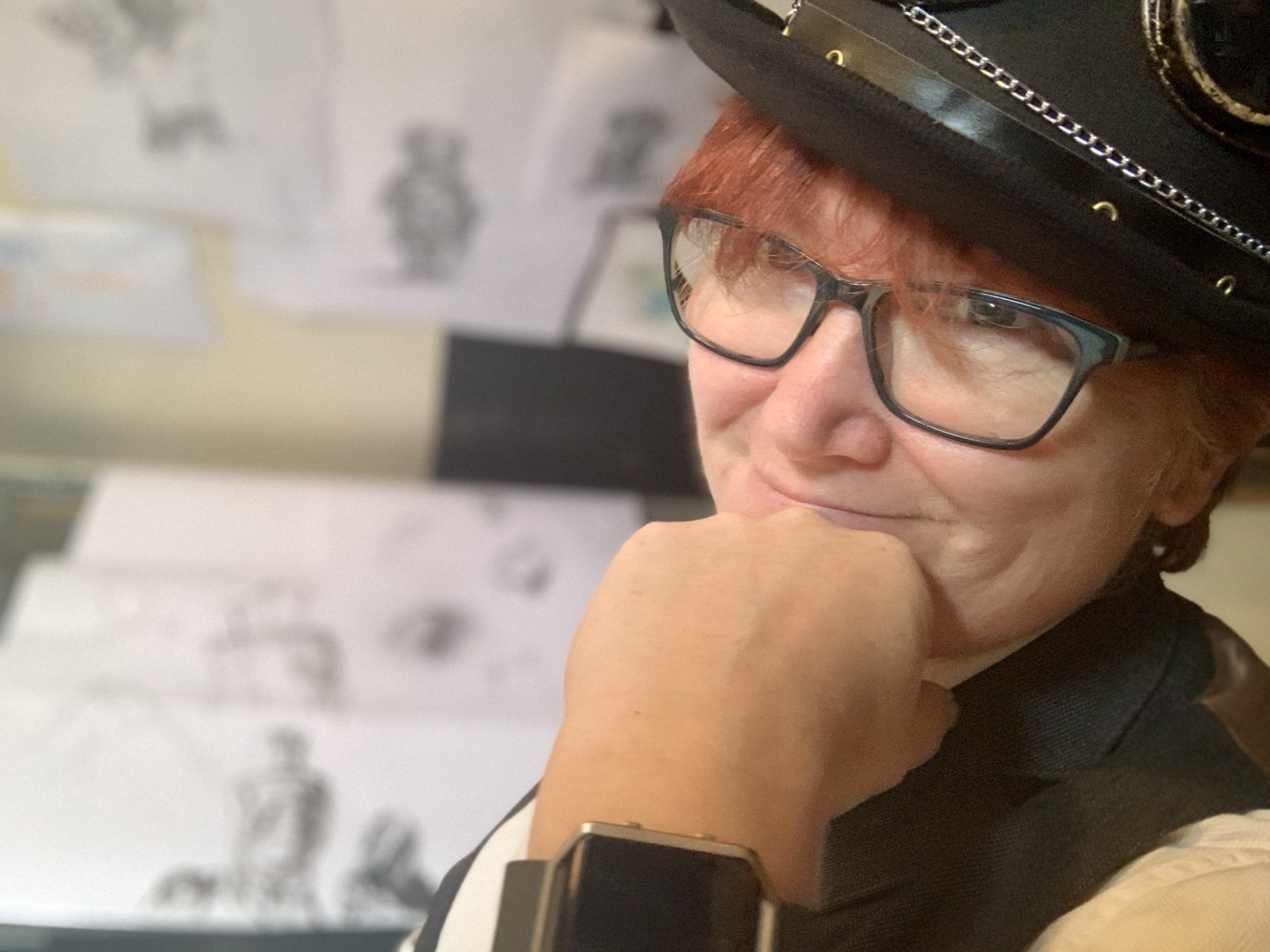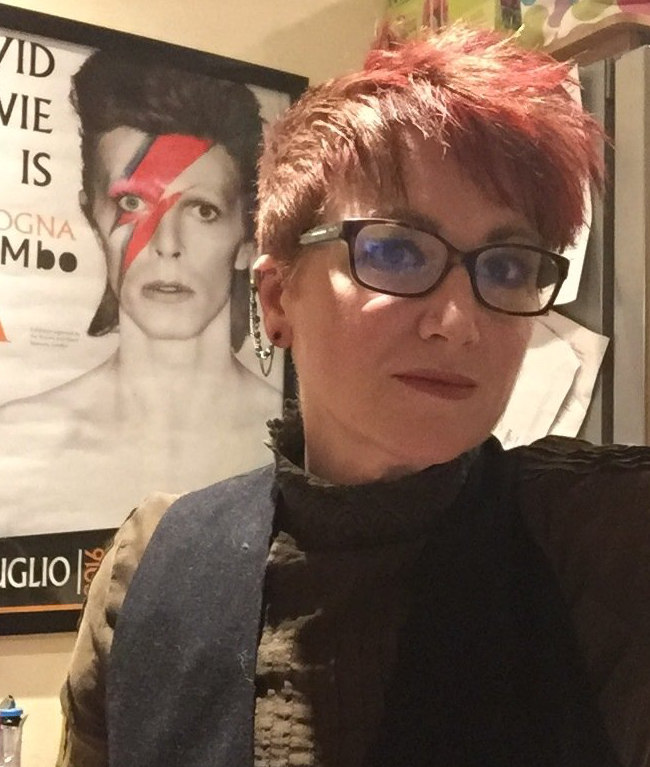The Inner Family
The personalities that form Becky newell’s system
Jack
Jack: Fine Artist and Our Most Present Personality
Jack is a fine artist and the personality most often present in social settings, alongside Fi. Though he has struggled to express emotions in words, Jack brings a wealth of experience to his art. He uses his creative process to explore and bring form to his thoughts, with color and light playing a significant role in his work. Jack’s bold imagery reflects an unflinching commitment to truth—at the heart of every piece he creates is the question, “Am I being truthful?”
Closely connected to Elby, the heart of our inner family, Jack is our lion. While often seen as the family’s protector, he is far from one-dimensional. Both he and Elby carry many of our shared experiences, and Jack serves as a fierce defender of us all.
Fi
Fi: The Creative Visionary
Fi views the world from a unique perspective, crafting familiar yet distinct realities. While her work can sometimes be moody, she finds magic in the shadows, noticing people and places others might overlook. She draws inspiration from our moments of dissociation, co-consciously documenting our journeys through photography.
Fi works across a variety of mediums, experimenting with photography, ink, and bleach, but she’s always ready to explore any material at hand in the studio.
A powerful and determined force, Fi channels her strength into compassion and pragmatism within our inner family. Often present alongside Jack, particularly in family settings.
Becky
Becky has not been around for a long while, for any length of time, though it was Becky that was present for a great deal of our thirties and became terribly ill with severe hemilplegic migraine. Painting with acrylic and acrylic inks Becky exhibited and gained success in the Christian art industry.
Always linked to Jack it was Becky that took the bravest steps by seeking help and speaking out when we began experiencing flashbacks. It was also Beckys bravery that hand in hand with Jack enabled us to give voice to D.I.D. finally.
There was no question of a separation between the family, Beckys first question regarding D.I.D during therapy was ‘ you won’t seperate me from Jack though will you?’. Though Becky is very rarely present socially she is in and around our life continually as all the family is.
Stephen
Stephen: The Stoic Poet
Stephen delivers his poetry as straightforward observations, never imposing his wisdom, though we often wish he would. He is very much his own person, offering only what he sees. As an older member of our family, Stephen provides a calming equilibrium.
A gruff socialist, atheist, and stoic, he assigns little value to his poems, scribbling them down for us to find and use as we see fit. His Northern accent, though its origin is unknown, lends a distinctive rhythm to his words. Stephen shares a particularly strong bond with Alfie, and his quiet presence brings a sense of calm to our younger family members.
Though he remains out of the social spotlight and has only recently begun to share his work, Stephen’s influence is felt deeply within our inner family.
Elby
Elby: The Blossoming Artist
Elby is the youngest member of our family, and after several years of therapy, she’s become an absolute bundle of joy! Slowly learning to build relationships, Elby has used creativity to communicate and make sense of her place and experiences in the world. She expresses herself through shapes, imagery, and, most significantly, color—both in her drawings and her writing.
Elby has a deep love for rabbits, her cat, and the family she is beginning to trust. We owe an immense debt of gratitude to our therapist for the compassionate nurturing that has helped Elby blossom into her creative self.
Recently, Elby has begun to share her story through art, working with pastels and exploring Fi’s inks to create some extraordinary pieces. Her pastel work is graphic in nature and may require a trigger warning.
Alfie
Alfie: The Inquisitive Explorer
Alfie is an energetic and inquisitive child, completely different in his interests from the rest of us, yet someone we all cherish deeply. If you’re lucky enough to meet Alfie, you’ll love him—everyone does! Though he doesn’t contribute directly to our creative work, his influence is felt throughout our family.
Alfie has a growing passion for learning, studying free courses on Open University in subjects like physics, astronomy, philosophy, and social science. His love for science, particularly astrophysics, shines through—Professor Brian Cox is his hero. But Alfie’s curiosity knows no bounds, and he often immerses himself in philosophy as well.
He has a fascination with patterns, whether in behavior, nature, or life itself, and writes extensively about his latest theories. His gentle approach to observing life serves him well in his interest in ecology, particularly in studying bugs and the natural world.
Alfie represents the beginnings of everything we never became, and we strive to support him in his boundless thirst for knowledge.
Why does Dissociative Identity Disorder happen? (trigger warning)
- who
At a time when the brain is developing personality ,around the age of 5 and under, children who are emotionally and physically tortured and abused may develop Dissociative Identity Disorder as a means to cope with repetitive unbearable trauma.
In the absence of being unable to either take flight or defend oursleves, in the face of repeated severe threat the brains overiding safety mechanism kicks in.
Dissosociation itself its not uncommon. Many people who have experienced any level of traumatic event will often report that they
'can't remember what happened'
or that the memories are splintered, or even that they could see the event from
'outside of themselves'.
For those children who experience this when their brain is developing personality, and experiencing it regularly, that dissociative state can develop into personality itself. the stem instead of growing into one, splinters into several, and the child learns to dissociate as a knee jerk reaction to any trigger.
- What
There are many misconceptions about Dissasociative Identity Disorder largely given to the fascination that people have with the multiple of personalities that people with the condition have. Living with the condition however brings with it far more complications than the media has interest to explore.
D.I.D. is a Forensic condition, which means it is an injury that someone gave you. Many people who have D.I.D. have been Ritually Abused. Though not everyone who has been Ritually Abused has D.I.D, there is a high proportion of survivors who live with the condition.
Often coming to terms with the cause of the abuse is as difficult as learning to balance life and live with it.
Although there are many challenges that face most people struggling to find balance it is possible.
Eating disorders, addictions, suicide attempts, self harm and depression are just some of the difficulties that may need to be overcome by those with the condition. Therapy is a long and difficult process and needs to be rooted in the trauma of the intial injury.
Far from being violent, as portrayed for the convenience of many film plots and stories, people with D.I.D have been the victims of some of the most inhumane violence possible.
- Why
Ritual Abuse begins at an extremely young age, sometimes from birth. It is psuedo religious in nature, secretive, powerful and highly organised. some families may have been involved in abuse circles for generations. Methods are highly sophisticated and members of the groups come from all levels of society. They will be upstanding members of your village, town, church, school, police force or member of parliament.
It is simple to see how easily a child can be convinced of anything. When we think of Christmas, we all consprire to convince the children in the magic of Santa Claus. How easy it is then to turn that power into something sinister.
Children born into a Ritually Abusive network are trained from the earliest years into powerlesness. They are given an avalanche of conflicting messages such as; they are evil/ they are sacred, they are loved/they are worthless. The conflicting messages from primary care givers, and extended influential people, leaves the child emotionally at sea. Often a child will be governed by extreme rules and regulations that the outside world will simply perceive as 'strict'. These rules will be embibed with terror and the child will operate on a level of hyper vigilence.
Sadly the emotional abuse is designed only to keep the veil of secrecy for the network and ensure the compliance from the child.
Children throughout the western world, who have survived, report the same experiences: sexual torture, multiple rape, canabolism, confinement, bestiality and witnessing murder. All of the practices are common place as part of Ritual Abuse. Other aspects of abuse are often associated with it too, such as prostitution and the making of pornagraphic material.
It isnt hard to see why a child, at an age when their personality is developing, with these experiences will learn to dissociate. Why their brain will develop an injury.
What is a travisty of justice is that, as yet in British courts, D.I.D. as a condition itself cannot be accepted as evidence for a crime having been committed.
- Who can give me sound information
There is a lot of conflicting information circulating in the public areana about Dissociative Identity Disorder. Films such as 'Split', whilst in part accurately done, poorly portray the actual experience. People who have generally experienced the worst kind of violence are portrayed as violent themselves. It is another violation which adds stigma to a difficult condition.
It is important to establish that the source of your facts is well intentioned. Ritual Abuse networks are loud in their decrying of every aspect of survivors claims including survivors injurys.
for more information visit any of these reputable sites :
www.firstpersonplural.org.uk
www.casra.org.uk
www.rans.org.uk
www.isstd.org
https://www.thesurvivorstrust.org
Watch this video, from Wilfred Wong, for more in depth information. (Trigger Warning)
https://youtu.be/yRLZh0u6Db4






